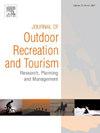Experiential value and environmentally responsible behavioral intention in rock-climbing tourism: The role of place attachment and biospheric value
IF 3.6
3区 管理学
Q1 HOSPITALITY, LEISURE, SPORT & TOURISM
Journal of Outdoor Recreation and Tourism-Research Planning and Management
Pub Date : 2024-10-07
DOI:10.1016/j.jort.2024.100829
引用次数: 0
Abstract
With increasing emphasis on environmental issues in outdoor leisure tourism, understanding the environmentally responsible behavioral intention (ERBI) of tourists is crucial to sustainable development. We explored the novel chain-mediating effect of experiential value on ERBI through place attachment and biospheric value among 300 recreational climbers in Yangshuo County, Guilin City. Using confirmatory factor analysis (CFA) and structural equation modeling (SEM), we found that the experiential value of climbing resorts had a direct effect on place attachment and biospheric value. Experiential value and place attachment had a moderate effect on ERBI, while biospheric value had a positive effect on ERBI. However, experiential value and place attachment indirectly influenced ERBI through the mediating effect of biospheric value. Finally, experiential value indirectly affected ERBI via the chain-mediating effects of place attachment and biospheric value. These findings extend existing theoretical frameworks by elucidating previously underexplored chain-mediation relationships. Practical insights derived from this study include strategies for enhancing the management and environmental protection of rock-climbing resorts. These strategies should focus on deepening the emotional connection between recreational climbers and the environment through innovative marketing approaches that emphasize tailored environmental protection activities, community involvement, and sustainable tourism practices.
Management implications
The findings suggest three innovative strategies, building on existing practices, to foster sustainable tourism in rock-climbing resorts by connecting tourists with the environment. First, immersive programs such as ecotourism, wildlife observation, and multimedia experiences would enhance experiential value. These programs can promote environmentally responsible behavior by actively engaging tourists in environmental education and encouraging deeper interactions with nature, fostering place attachment and biospheric values. Second, content marketing, including storytelling and environmental campaigns that emphasize the ecological significance of rock-climbing resorts could position them as advocates for environmental conservation, especially ecosystem and biodiversity preservation. Third, personalized marketing can strengthen place attachment. Tourists could share personal photos on social media and receive symbolic rewards, such as sustainable tourism certificates. These strategies will actively engage tourists in environmental conservation and sustainable tourism efforts, foster long-term participation, and enhance the unique appeal of resorts as leaders in eco-friendly tourism.
Management implications
The findings suggest three innovative strategies, building on existing practices, to foster sustainable tourism in rock-climbing resorts by connecting tourists with the environment. First, immersive programs such as ecotourism, wildlife observation, and multimedia experiences would enhance experiential value. These programs can promote environmentally responsible behavior by actively engaging tourists in environmental education and encouraging deeper interactions with nature, fostering place attachment and biospheric values. Second, content marketing, including storytelling and environmental campaigns that emphasize the ecological significance of rock-climbing resorts could position them as advocates for environmental conservation, especially ecosystem and biodiversity preservation. Third, personalized marketing can strengthen place attachment. Tourists could share personal photos on social media and receive symbolic rewards, such as sustainable tourism certificates. These strategies will actively engage tourists in environmental conservation and sustainable tourism efforts, foster long-term participation, and enhance the unique appeal of resorts as leaders in eco-friendly tourism.
攀岩旅游中的体验价值和对环境负责的行为意向:地方依恋和生物圈价值的作用
随着户外休闲旅游对环境问题的日益重视,了解游客的环境责任行为意向(ERBI)对可持续发展至关重要。我们在桂林市阳朔县的 300 名休闲登山者中探讨了体验价值通过地方依恋和生物圈价值对环境责任行为意向的新型链中介效应。通过确证因子分析(CFA)和结构方程建模(SEM),我们发现攀岩胜地的体验价值对地方依恋和生物圈价值有直接影响。体验价值和地方依恋对ERBI有中等程度的影响,而生物圈价值对ERBI有积极影响。然而,体验价值和地方依恋通过生物圈价值的中介效应间接影响了ERBI。最后,体验价值通过地方依恋和生物圈价值的连锁中介效应间接影响了ERBI。这些发现扩展了现有的理论框架,阐明了以前未充分探索的连锁中介关系。本研究得出的实用见解包括加强攀岩胜地管理和环境保护的策略。这些策略应侧重于通过创新的营销方法加深休闲攀岩者与环境之间的情感联系,强调量身定制的环境保护活动、社区参与和可持续旅游实践。 管理启示研究结果在现有实践的基础上提出了三项创新策略,通过将游客与环境联系起来,促进攀岩胜地旅游业的可持续发展。首先,生态旅游、野生动物观察和多媒体体验等身临其境的项目将提高体验价值。这些项目可以通过积极吸引游客参与环境教育,鼓励游客与大自然进行更深入的互动,培养对地方的依恋和生物圈价值,从而促进对环境负责任的行为。第二,内容营销,包括强调攀岩胜地生态意义的讲故事和环保活动,可将其定位为环境保护的倡导者,尤其是生态系统和生物多样性的保护。第三,个性化营销可以加强对地方的依恋。游客可以在社交媒体上分享个人照片,并获得象征性奖励,如可持续旅游证书。这些策略将积极吸引游客参与环境保护和可持续旅游工作,促进长期参与,并增强度假村作为生态友好型旅游领导者的独特吸引力。 管理启示研究结果在现有实践的基础上提出了三项创新策略,通过将游客与环境联系起来,促进攀岩度假村的可持续旅游。首先,生态旅游、野生动物观察和多媒体体验等身临其境的项目将提高体验价值。这些项目可以通过积极吸引游客参与环境教育,鼓励游客与大自然进行更深入的互动,培养对地方的依恋和生物圈价值,从而促进对环境负责任的行为。第二,内容营销,包括强调攀岩胜地生态意义的讲故事和环保活动,可将其定位为环境保护的倡导者,尤其是生态系统和生物多样性的保护。第三,个性化营销可以加强对地方的依恋。游客可以在社交媒体上分享个人照片,并获得象征性奖励,如可持续旅游证书。这些策略将积极吸引游客参与环境保护和可持续旅游工作,促进长期参与,并增强度假村作为生态友好型旅游领导者的独特吸引力。
本文章由计算机程序翻译,如有差异,请以英文原文为准。
求助全文
约1分钟内获得全文
求助全文
来源期刊

Journal of Outdoor Recreation and Tourism-Research Planning and Management
HOSPITALITY, LEISURE, SPORT & TOURISM-
CiteScore
6.70
自引率
5.30%
发文量
84
期刊介绍:
Journal of Outdoor Recreation and Tourism offers a dedicated outlet for research relevant to social sciences and natural resources. The journal publishes peer reviewed original research on all aspects of outdoor recreation planning and management, covering the entire spectrum of settings from wilderness to urban outdoor recreation opportunities. It also focuses on new products and findings in nature based tourism and park management. JORT is an interdisciplinary and transdisciplinary journal, articles may focus on any aspect of theory, method, or concept of outdoor recreation research, planning or management, and interdisciplinary work is especially welcome, and may be of a theoretical and/or a case study nature. Depending on the topic of investigation, articles may be positioned within one academic discipline, or draw from several disciplines in an integrative manner, with overarching relevance to social sciences and natural resources. JORT is international in scope and attracts scholars from all reaches of the world to facilitate the exchange of ideas. As such, the journal enhances understanding of scientific knowledge, empirical results, and practitioners'' needs. Therefore in JORT each article is accompanied by an executive summary, written by the editors or authors, highlighting the planning and management relevant aspects of the article.
 求助内容:
求助内容: 应助结果提醒方式:
应助结果提醒方式:


